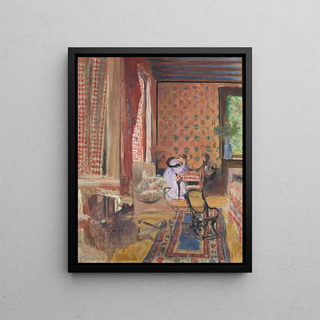Art print | At the board game - Édouard Vuillard


View from behind

Frame (optional)
Art print of a board game - Édouard Vuillard – Captivating Introduction
In the fascinating world of art, some works stand out for their ability to capture the very essence of everyday life. "Au jeu de société" by Édouard Vuillard is one of those creations that evokes an intimate and warm atmosphere. This painting, created at the end of the 19th century, immerses us in the universe of a bourgeois salon where the game becomes a pretext for sociability. The skillfully arranged composition, where the characters interact in a subdued ambiance, invites the viewer to delve into their world. The soft light filtering through the windows and the delicate textile patterns reinforce this sense of closeness, making the artwork even more captivating and immersive.
Style and uniqueness of the work
Vuillard's style is characterized by a subtle use of color and shapes, which blend to create a unique atmosphere. In "Au jeu de société," the artist employs warm tones and repetitive patterns that evoke domestic life, while playing with textures and shadows. The characters, although depicted figuratively, seem almost to dissolve into their environment, demonstrating the harmony between the individual and their living space. This fusion between subject and decor is emblematic of the Nabi movement, of which Vuillard was a passionate representative. The way he captures the gestures and expressions of the players, while incorporating decorative elements, creates a rich and nuanced visual dynamic, inviting personal interpretation of the work.
The artist and his influence
Édouard Vuillard, born in 1868, is one of the major artists of the late 19th and early 20th centuries. Affiliated with the Nabi group, he revitalized the pictorial language by integrating decorative elements into his compositions. His intimate approach and interest in everyday life influenced many artists, both contemporaries and successors. Vuillard managed to capture the spirit of an era, engaging with modernity while remaining deeply rooted in his artistic roots. His work, at the crossroads between symbolism and Impressionism, paved the way for a new way of seeing and representing

Matte finish

View from behind

Frame (optional)
Art print of a board game - Édouard Vuillard – Captivating Introduction
In the fascinating world of art, some works stand out for their ability to capture the very essence of everyday life. "Au jeu de société" by Édouard Vuillard is one of those creations that evokes an intimate and warm atmosphere. This painting, created at the end of the 19th century, immerses us in the universe of a bourgeois salon where the game becomes a pretext for sociability. The skillfully arranged composition, where the characters interact in a subdued ambiance, invites the viewer to delve into their world. The soft light filtering through the windows and the delicate textile patterns reinforce this sense of closeness, making the artwork even more captivating and immersive.
Style and uniqueness of the work
Vuillard's style is characterized by a subtle use of color and shapes, which blend to create a unique atmosphere. In "Au jeu de société," the artist employs warm tones and repetitive patterns that evoke domestic life, while playing with textures and shadows. The characters, although depicted figuratively, seem almost to dissolve into their environment, demonstrating the harmony between the individual and their living space. This fusion between subject and decor is emblematic of the Nabi movement, of which Vuillard was a passionate representative. The way he captures the gestures and expressions of the players, while incorporating decorative elements, creates a rich and nuanced visual dynamic, inviting personal interpretation of the work.
The artist and his influence
Édouard Vuillard, born in 1868, is one of the major artists of the late 19th and early 20th centuries. Affiliated with the Nabi group, he revitalized the pictorial language by integrating decorative elements into his compositions. His intimate approach and interest in everyday life influenced many artists, both contemporaries and successors. Vuillard managed to capture the spirit of an era, engaging with modernity while remaining deeply rooted in his artistic roots. His work, at the crossroads between symbolism and Impressionism, paved the way for a new way of seeing and representing






